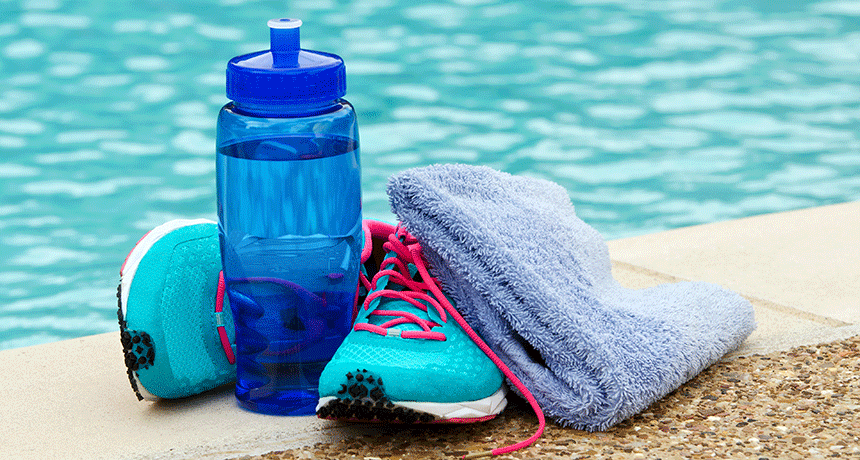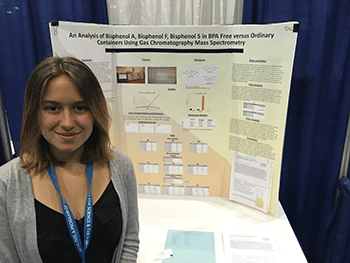BPA-free plastic may host BPA-like chemical, teen finds
Plastics advertised as ‘BPA-free’ may contain the potentially toxic BPF instead

Many plastic water bottles used to contain BPA to make them hard and transparent. But in recent years, that BPA has sometimes been replaced a potentially worrisome relative of BPA that's known as BPF, a teen now shows.
leekris/istockphoto
LOS ANGELES, Calif. — Most people probably don’t think much about what is in the plastics they use. But Anna Kucera, 16, did. Bisphenol A, or BPA, is a building block of the clear, hard plastics long used in many products, especially water bottles. But when health concerns about BPA emerged, many companies began making their clear plastic with other substances. And that made the junior at Canterbury School in Fort Myers, Fla., wonder what replaced the BPA in “BPA-free” plastics. With a bit of chemistry, she now shows that in some plastics, BPA has been replaced with one of its potentially toxic chemical cousins. Known as bisphenol F, or BPF, this other chemical leaches out of those plastics at amounts 10 times higher than the levels that leach from BPA-based plastics.
The teen showed off the results of her project at the Intel International Science and Engineering Fair, or ISEF. The competition brought together 1,800 high school students from around the world to show off their research this year. (ISEF was created by Society for Science & the Public and is sponsored by Intel. SSP also publishes Science News for Students and this blog.)
Many hard clear plastic products used for eating, drinking or with kitchen appliances are made from polycarbonate. BPA is this plastic’s basic building block. Studies have shown BPA can leach out of heated water bottles or the paper for store receipts. BPA can then enter the body. There, its acts as an endocrine disruptor. That means that it mimics the actions of hormones — chemicals from glands that play important roles throughout the body.
Now, it is common to find plastics labeled as “BPA-free.” Anna wondered what they were made from. “There are so many bottles that are ‘BPA-free.’ They must substitute something for the BPA because they look exactly the same,” she says. She read that BPA might be replaced with other endocrine disruptors, such as BPF and bisphenol S (BPS).
The teen decided to investigate what was in those BPA-free bottles. She purchased 10 plastic water bottles labeled “BPA-free” and 10 bottles that didn’t have the label. “I assumed if there was no BPA-free designation they possibly could use BPA, because it’s generally a common thing to use,” Anna says. For her control, she purchased 10 glass bottles.
Working with her father Paul Kucera and chemist Daniel Paull at Florida Gulf Coast University in Fort Myers, the teen filled her bottles with a chemical called acetonitrile (Ah-SEE-tow-NY-tryle). It is a solvent, or a material into which other chemicals dissolve. She put her filled bottles in a tub of water at 55° Celsius (131° Fahrenheit) for 72 hours.
Then she ran the fluid from inside the bottles through a gas chromatograph linked to a mass spectrometer. A gas chromatograph separates chemicals in a mix. The mass spectrometer identifies them. Anna hunted for BPA, BPS and BPF in her samples.

None of her samples had any BPS. The fluid from bottles that had no BPA-free label did have some BPA, about 0.440 parts per million, or around 0.44 milligram (0.000015 ounce) of BPA per liter (0.26 gallon) of water. That’s would be equal to dissolving about 1 kilogram (2.2 pounds) of BPA in an Olympic swimming pool.
The fluid from BPA-free bottles had no measurable BPA. But they did contain a lot of BPF. Anna measured about 4.7 milligrams (0.00016 ounce) per liter (0.26 gallon) of BPF in the acetonitrile that had been in those bottles. That’s 10 times as the amount of BPA that had leached into the fluid from the bottles that weren’t BPA-free. “What [the manufacturers are] doing is substituting something very similar for BPA,” she says.
A chemical extraction may get some of the BPF out of the water bottle. But that doesn’t necessarily mean that BPF would leach out of a plastic bottle and into someone’s water at the same concentrations. However, Anna is worried. BPS has been shown to cause health problems in rats and zebrafish. And studies affex sex-hormone levels in human cells and can mimic estrogen in zebrafish. “It may not be safe to believe that a BPA-free bottle is any better than an ordinary plastic bottle,” the teen says. “There’s quite a lot of BPF [leaching out].”
Anna hopes that chemists will find another chemical to use in plastics. “If they could find something that could achieve the same thing, but was a better substitution that was more environmentally friendly,” she says. “That would be much better.”
The teen may hunt for that new chemical herself. Anna wants to be a chemical engineer. In the meantime, she won’t drink out of plastic. “I prefer glass,” she says. “It’s always the best alternative because nothing can be extracted from a glass bottle.”
Follow Eureka! Lab on Twitter







